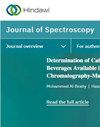基于近红外光谱的何首乌快速质量评估
IF 2.1
4区 化学
Q4 BIOCHEMICAL RESEARCH METHODS
引用次数: 0
摘要
准确、及时地测定水分、链烯苷和蒽醌苷等质量控制指标,对于评估何首乌的质量至关重要。近红外光谱是一种无损分析技术,与传统方法相比,它在评估含量水平方面提供了一种更理想的方法。在这项研究中,使用了各种光谱预处理技术对原始光谱数据进行预处理。使用偏最小二乘回归(PLSR)方法将光谱数据与三组分含量的测定相关联。然后使用竞争性自适应加权采样(CARS)、蒙特卡罗无信息变量消除(MCUVE)和随机蛙跳(RF)等不同算法进行模型简化和特征选择。数据表明,在所有三个模型评估指标上,对光谱数据进行一阶解卷积导数(1st Dev.)处理的方法都优于其他方法。水分、链烯苷和蒽醌苷的 PLSR 模型的校准判定系数(R2C)分别为 0.82、0.52 和 0.58,交叉验证的均方根误差(RMSECV)分别为 0.91%、0.预测决定系数 (R2P) 为 0.72、0.28 和 0.54,预测均方根误差 (RMSEP) 为 0.65%、0.81% 和 0.75%,相对百分比差异 (RPD) 为 1.7、1.0 和 0.8。使用 CARS 对模型进行优化后,R2C 增加了 0.15%、0.41% 和 0.34%,RMSECV 减少了 0.53%、0.32% 和 0.24%,R2P 增加了 0.21%、0.63% 和 0.35%,RMSEP 减少了 0.36%、0.41% 和 0.31%,RPD 增加了 1.1、0.9 和 0.6,显著提高了模型的预测能力。该研究为快速检测何首乌的顺应性提供了一种可行的方法。为了进一步提高模型的性能和适用性,有必要不断扩大样本集,增加不同品种和地点的样本,以实现广泛的差异。本文章由计算机程序翻译,如有差异,请以英文原文为准。
Rapid Quality Assessment of Polygoni Multiflori Radix Based on Near-Infrared Spectroscopy
The precise and prompt determination of quality control indicators such as moisture, stilbene glycosides, and anthraquinone glycosides is crucial in assessing the quality of Polygoni Multiflori Radix. Near-infrared spectroscopy is a nondestructive analytical technique that offers a more desirable approach than traditional methods for assessing content levels. In this study, various spectral preprocessing techniques were used to preprocess the raw spectral data. The spectral data were correlated with the determination of three-component contents using the partial least squares regression (PLSR) method. Then different algorithms, such as competitive adaptive weighted sampling (CARS), Monte Carlo uninformative variable elimination (MCUVE), and random frog hopping (RF), were used for model simplification and feature selection. The data suggest that the first-order deconvolution derivative (1st Dev.) processing of the spectral data is superior to other methods in all three model evaluation metrics. The PLSR model for moisture, stilbene glycosides, and anthraquinone glycosides produced the calibration coefficient of determination (R2C) of 0.82, 0.52, and 0.58, the root mean square error of cross validation (RMSECV) of 0.91%, 0.77%, and 0.69%, the prediction coefficient of determination (R2P) of 0.72, 0.28, and 0.54, the root mean square error of prediction (RMSEP) of 0.65%, 0.81%, and 0.75%, and relative percentage differences (RPDs) of 1.7, 1.0, and 0.8. After optimizing the model using CARS, R2C increased by 0.15%, 0.41%, and 0.34%, RMSECV decreased by 0.53%, 0.32%, and 0.24%, R2P increased by 0.21%, 0.63%, and 0.35%, RMSEP decreased by 0.36%, 0.41%, and 0.31%, and RPD increased by 1.1, 0.9, and 0.6, significantly improving the predictive capacity of the model. This research provides a feasible method for rapid compliance testing of Polygoni Multiflori Radix. To further improve the model’s performance and applicability, it is necessary to continuously expand the sample set with different varieties and locations for wide variation.
求助全文
通过发布文献求助,成功后即可免费获取论文全文。
去求助
来源期刊

Journal of Spectroscopy
BIOCHEMICAL RESEARCH METHODS-SPECTROSCOPY
CiteScore
3.00
自引率
0.00%
发文量
37
审稿时长
15 weeks
期刊介绍:
Journal of Spectroscopy (formerly titled Spectroscopy: An International Journal) is a peer-reviewed, open access journal that publishes original research articles as well as review articles in all areas of spectroscopy.
 求助内容:
求助内容: 应助结果提醒方式:
应助结果提醒方式:


